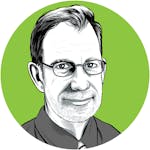"The issue of wealth and income inequality is the great moral issue of our time, it is the great economic issue of our time and it is the great political issue of our time."
So says Sen. Bernie Sanders, I-Vt., pronouncing a sort of timeless battle cry for self-labeled socialists like himself — for whom class conflict is always and everywhere the "great issue" at hand.
But Sanders' declaration also reflects an article of contemporary conventional wisdom, understandly endorsed by nearly every armchair analyst of today's political and economic debates.
The proposition that economic inequality has radically increased over the past 40 years or so, to levels not seen since the days of Scrooge and Cratchit, has become the stuff of common knowledge — one of the most widely disseminated and confidently repeated economic claims of our time.
If the reality might actually be more complicated than what "everybody knows," it seems like a complication worth considering.
And in fact, over the past several years, a number of impressive studies have appeared that do suggest a less drastic parting of the ways between rich and poor. To be clear, none of them dispute the essential picture of growing inequality after the mid-1970s or so. But they argue that the most frequently cited calculations exaggerate the trend.
The best-known claims — simply put, that substantially all income growth in recent years and even recent decades has gone to the well-off, and much of it to the super-rich "1 percent" and above — emerged from research going back to the early 2000s by superstar economists Thomas Piketty of the Paris School of Economics and Emmanuel Saez of Berkeley.
One of the more intriguing recent developments is that Piketty and Saez, using modified definitions and methods, have themselves done some of the analysis that now calls their earlier estimates of inequality's rise into question.
Other complicating calculations come from scholars at the respected Congressional Budget Office, the Treasury Department, the Joint Committee on Taxation, the Urban Institute and elsewhere.
Stephen J. Rose of the Urban Institute has newly summarized the state of this research by comparing six inequality studies in a paper jauntily subtitled "Piketty and Company Are Not the Only Game in Town."
The rules of the various "games" make for eye-popping differences in their interpretations of recent economic history. Rose reports that estimates of the change in America's "median" (or midpoint) income from 1979-2014 range from an actual decline of 8 percent after accounting for inflation (under Piketty and Saez's original methodology) to an after-inflation increase of 51 percent in CBO's latest report.
Similarly, the richest 10 percent of earners captured 100 percent of economic growth over those same 35 years in the initial Piketty/Saez analysis, but only 55 percent in the duo's more recent study (and 46 percent according to CBO).
And the 1 percent? Their share of total income more than doubled, to 22 percent, in the original Piketty/Saez calculation. CBO says it grew more slowly, and only to 13.3 percent.
Strikingly different pictures. Yet there's no suggestion here that anyone is deliberately distorting facts — only that there are numerous contrasting ways of defining and estimating income, different ways of measuring inflation and different decisions an analysis can make about how and whether to account for taxes, government benefits (cash or noncash), public services and so on and on.
For example: Should employer and/or government health care benefits be counted as income? How about an employer's part of Social Security tax? Food stamps? Capital gains, realized or unrealized? Should one compare individuals, or households of varying sizes? How, if at all, should we account for the value of "public goods" — roads, airports, fire departments, national defense?
Answers to these and many other questions matter a great deal to one's final conclusion. In general, Rose explains, the more broadly income is defined as the total "value of resources people consume," and the more thoroughly taxes and public benefits and variations in household size are accounted for, the less extreme appears the increase in inequality.
Yet impressive arguments can be made for many different approaches to arriving at the most meaningful measure of income and well-being — and therefore, the best measure of inequality. There is no one right answer.
But the point is that one answer does seem to have become what "everybody knows" about inequality — and it is based on the early 2000s analytical method that Rose reports was consistently, in his comparisons, "the outlier, showing the most increased inequality."
Rose's bottom line "consensus" calculations show that "instead of stagnating, real median incomes grew by just over 40 percent ... from 1979 to 2014" while the top 10 percent of income earners captured 45 percent of income growth and the top 1 percent increased its share of income by 3.5 percentage points.
That may well be a portrait of concentrating wealth and only modest progress for the middle class. But, Rose concludes, "common perceptions that all income gain went to the top … and middle class incomes stagnated (or even declined) are wrong."
D.J. Tice is at Doug.Tice@startribune.com.

D.J. Tice: No room for debate — it's been a great career

Dogmas of the stormy present confuse Civil War debate

The infinite elsewhere



